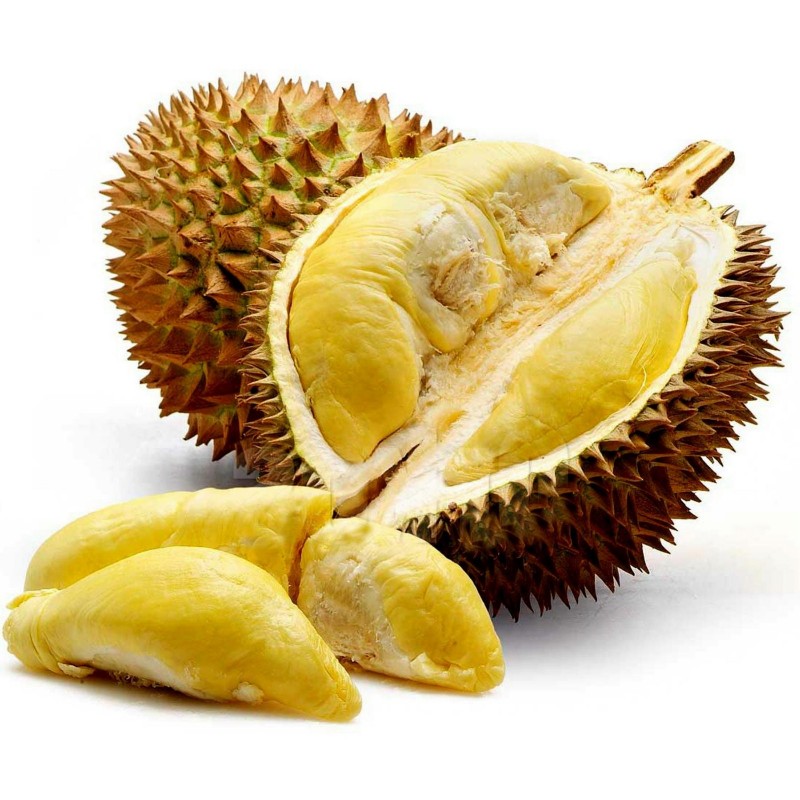
Giant plant (with giant fruits)

Coming Soon









The durian is the fruit of several tree species belonging to the genus Durio. The name "durian" is arrived from the Malay language word for duri or "spike", a reference
The durian is the fruit of several tree species belonging to the genus Durio. The name "durian" is arrived from the Malay language word for duri or "spike", a reference to the numerous spike protuberances of the fruit, together with the noun-building suffix -an. There are 30 recognized Durio species, at least nine of which produce edible fruit, and over 300 named varieties in Thailand and 100 in Malaysia. Durio zibethinus is the only species available in the international market: all other species are sold only in their local regions. There are hundreds of durian cultivars; many consumers express preferences for specific cultivars, which fetch higher prices in the market.
Regarded by many people in southeast Asia as the notorious "king of fruits", the durian is distinctive for its large size, strong odour, and formidable thorn-covered husk. The fruit can grow as large as 30 centimeters (12 in) long and 15 centimeters (6 in) in diameter, and it typically weighs one to three kilograms (2 to 7 lb). Its shape ranges from oblong to round, the color of its husk green to brown, and its flesh pale yellow to red, depending on the species.
Some people regard the durian as having a pleasantly sweet fragrance; others find the aroma overpowering with an unpleasant odor. The smell evokes reactions from deep appreciation to intense disgust and has been described variously as rotten onions, turpentine, and raw sewage. The persistence of its odor, which may linger for several days, has led to the fruit's banishment from certain hotels and public transportation in Southeast Asia.
The durian, native to Southeast Asia, has been known to the Western world for about 600 years. The nineteenth-century British naturalist Alfred Russel Wallace described its flesh as "a rich custard highly flavored with almonds". The flesh can be consumed at various stages of ripeness, and it is used to flavor a wide variety of savory and sweet edibles in Southeast Asian cuisines. The seeds can also be eaten when cooked.
Temperature:
Durian is surprisingly tolerant of relatively low mean temperatures. There are places on the island of Java between 400-600 m [1300-2000 feet] altitude where durian is successfully grown that have a mean yearly normal temperature of just 23º C. (73º F.) Some research has indicated that growth is limited below a mean monthly temperature of 22º C. [71º F.]. The trees may survive occasional dips in temperature as low as 10º C. [50º F.], but may drop their leaves. On the other end of the spectrum, durian trees in India sometimes successfully tolerate high temperatures up to 46º C. [114º F.].
Water:
Durian trees need abundant rainfall or equivalent irrigation. In most areas of Asia where durians are grown, mean annual rainfall is greater than 2000 mm [75 inches]. Historically, though, the better production sites have developed in areas with annual mean rainfall totals of 3000 mm [125 inches] or more, well distributed throughout the year. There is no doubt, though, that drier zones can produce good crops with appropriate irrigation. In India, durian trees are often planted along the banks of streams, where the roots can reach the water. They do not do well very close to the ocean, having almost no tolerance for salinity in the soil.
Soil:
Durian trees grow best in a rich, deep, well-drained sandy clay or a clay loam (deep alluvial or loamy soil), high in organic matter, pH range of 6 - 7. Heavy clay soils are not supportive of good durian tree growth and health, as they do not drain well. Seedlings make more vigorous growth when potted into media that is light and sandy rather than high in clay content.
Data sheet

 Reviews (0)
Reviews (0)